
Abagrotis scopeops is a moth of the family Noctuidae first described by Harrison Gray Dyar Jr. in 1904. It is found in North America from southern British Columbia, south through western Montana, Idaho, Utah and Nevada down to southern California.
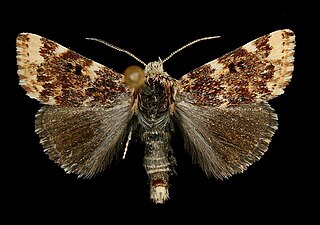
Schinia avemensis, the gold-edged gem, is a moth of the family Noctuidae. The species was first described by Harrison Gray Dyar Jr. in 1904. It is found in only three colonies in the southern prairie provinces of Canada, the Spirit Dunes at Spruce Woods Provincial Park, Manitoba; the Burstall dunes in south-western Saskatchewan; and in a small dune complex in the Red Deer River valley north of Bindloss. It will probably also be found in other active dune complexes in the southern parts of Alberta and Saskatchewan. It has also been recorded from Colorado.

Euxoa adumbrata, the sordid dart, is a moth of the family Noctuidae. The species was first described by Eduard Friedrich Eversmann in 1842. In North America it is found across northern Canada from Quebec to western Alaska, south to the northern parts of the United States, and in the mountains to Colorado. It is also found in Greenland, the coastal areas of Scandinavia and the Ural. It was recently recorded from Denmark, although this includes Euxoa lidia, which some authors regard to be a valid species.
Gazoryctra roseicaput is a moth of the family Hepialidae. It was described by Berthold Neumoegen and Harrison Gray Dyar Jr. in 1893. It is known from the mountains of western North America, including Washington, Oregon, British Columbia and Alberta.

Scopula luteolata is a moth of the family Geometridae. It is found in western North America. In Canada, the range extends from the mountains of south-western Alberta, north to Banff and west to Vancouver Island. In the United States, it has been recorded from Arizona, California, Montana, Nevada, New Mexico, Oregon, Washington and Wyoming. The habitat consists of montane wooded and shrubby openings and edges in forests.
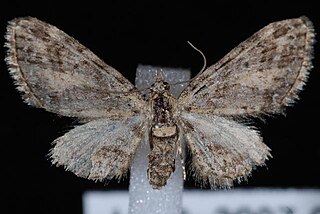
Eupithecia maestosa is a moth in the family Geometridae first described by George Duryea Hulst in 1896. It is found in North America from extreme western Alberta west to Vancouver Island, north to northern British Columbia and south to Texas and California. The habitat consists of wooded and shrubby areas.

Eupithecia borealis is a moth in the family Geometridae first described by George Duryea Hulst in 1898. It is found in North America, including Alberta, Arizona, British Columbia, California, Colorado, Manitoba, Michigan, Montana, New Brunswick, New Mexico, New York, Newfoundland and Labrador, Nova Scotia, Ontario, Quebec, Utah and Wyoming.
Eupithecia casloata is a moth in the family Geometridae first described by Harrison Gray Dyar Jr. in 1904. It is found in North America, including Yukon, British Columbia, Alberta, Saskatchewan, New Brunswick, Newfoundland and Labrador, Quebec, Washington, Montana, Oregon, Wyoming, Colorado, Utah, California, Maine and New Hampshire.

Eupithecia nimbicolor is a moth in the family Geometridae first described by George Duryea Hulst in 1896. It is found in North America from eastern Newfoundland and Labrador to western British Columbia and from Alaska to Arizona.
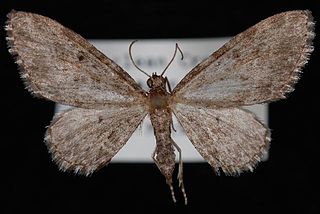
Eupithecia lachrymosa is a moth in the family Geometridae first described by George Duryea Hulst in 1900. It is found in North America from central Saskatchewan west to southern Vancouver Island, north to British Columbia and Alberta and south to California.
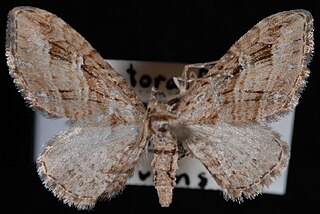
Eupithecia niphadophilata is a moth in the family Geometridae first described by Harrison Gray Dyar Jr. in 1904. It is found in North America from British Columbia and western Alberta south to New Mexico.

Eupithecia stellata is a moth in the family Geometridae first described by George Duryea Hulst in 1896. It is found in North America from central Manitoba to northern Alberta and south to California and Mexico.

Eupithecia niveifascia is a moth in the family Geometridae first described by George Duryea Hulst in 1898. It is found in North America from south-western Alberta west to Vancouver Island, north to northern coastal British Columbia and south to New Mexico.
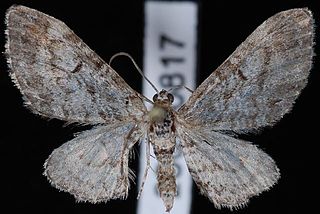
Eupithecia graefi, or Graef's pug, is a moth in the family Geometridae. The species was first described by George Duryea Hulst in 1896. It is found in North America from south-western Alberta west to Vancouver Island, north to Alaska and south to California. The habitat consists of wooded areas.

Eupithecia placidata is a moth in the family Geometridae first described by Taylor in 1908. It is found in western North America from British Columbia south to California.

Eupithecia misturata is a moth in the family Geometridae first described by George Duryea Hulst in 1896. It is widely distributed in western North America.
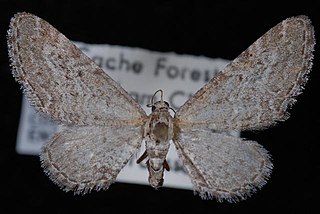
Eupithecia behrensata is a moth in the family Geometridae first described by Alpheus Spring Packard in 1876. It is found in North America from California north to British Columbia, Alberta and Saskatchewan.
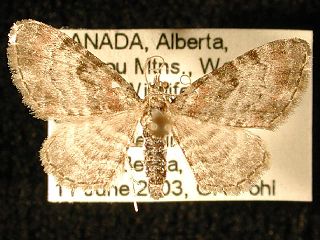
Eupithecia albicapitata is a moth in the family Geometridae first described by Alpheus Spring Packard in 1876. It is found from Newfoundland and Labrador to western British Columbia, north to Alaska and Alberta, south to New England and New York.

Eupithecia spermaphaga is a moth in the family Geometridae first described by Harrison Gray Dyar Jr. in 1917. It is found in western North America from British Columbia, through Oregon and Washington to Nevada and California.
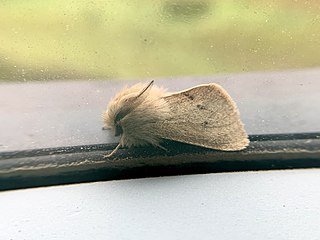
Spilosoma vagans, the wandering diacrisia or wandering tiger moth, is a moth in the family Erebidae. It was described by Jean Baptiste Boisduval in 1852. It is found in western North America, from southern California, southern Utah and central Colorado north to southern British Columbia and south-western Alberta. The habitat consists of drier forests, including open ponderosa pine forests and mixed hardwood-conifer forests.


















